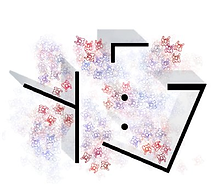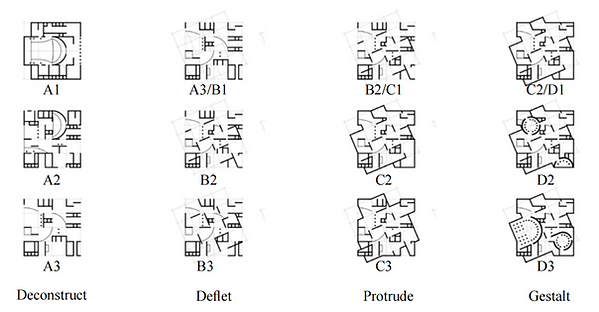
JIAQI HAN
BROKEN BRECHT
In the Immersive Drama, the audience is not expected to sit there passively. At a certain point when the action heats up, they are urged to get involved. In mid 20th century, Bertolt Brecht used the term fourth wall to alienate audience from the stage. But now, audience members who are activist by nature are most likely to step through The Fourth Wall and become active.
In this design, the traditional theater prototype was disrupted and reorganized, to propose a new theater model. Through the deconstruction and reorganization of the theater prototype, the boundary between the actors and the audience is blurred. Audience members still have the power to perform, and thus are transformed from spectators into spect-actors – activated spectators.
Theatre Design Studio
Site:Soho, New York
Tutor:Haohao Xu(arhaohaoxu@scut.edu.cn),
Original Individual Work,
modified with Xueying Li
Autumn 2017

It is not in the tragic characters that pity and fear manifest themselves — but rather in the spectators. Through those emotions the spectators are linked to the heroes.
-Augusto Boal
01 Broken Prototype to Retrospect
Bertolt Brecht, was a German theatre practitioner, playwright, and poet. One of Brecht's most important principles was what he called the Verfremdungseffekt. He proposed Epic Theatre①, where a play should not cause the spectator to identify emotionally with the characters or action before him or her, but should instead provoke rational self-reflection and a critical view of the action on the stage.
Verfremdungseffekt (translated as de-familiar-ization effect), refers to playing in such a way that the audience was hindered from simply identifying itself with the characters in the play.
Acceptance or rejection of their actions and utterances was meant to take place on a conscious plane, instead of,
as hitherto, in the audience's subconscious.

① Barnett David. Brecht. Bloomsbury Publishing Plc, 2015
Figure.Epic Theatre with Brecht's Drama
02 History of Theatre Prototype

The initial relationship between the audience and the actors was more equal, and later the audience and the actors were gradually separated while drama itself became eliteized since the Bertolt Brecht performance method appeared (the interaction between the audience and the actors was separated in the performance method) and The fourth wall① (the space is isolated from the interaction between the audience and the actors).
Before mid-20th, the drama was a form of art for everyone sitting in a large space, enriching citizen lives.
Can theatre return to the former relationship?
① Bell Elizabeth S. Theories of Performance. Sage. p. 203,2008. The fourth wall is a performance convention in which an invisible, imagined wall
separates actors from the audience. While the audience can see through this wall.
03 A New Prototype
Scholarly analysis of immersive theater is often Eurocentric: three main steps are often identified for creating an immersive and participatory theater experience①:
1.Disintegration of the barrier between audience and actors;
2.Placement of audience members into the narrative of the work;
3.Removal of social structures dividing known constructs from imagined ones/lack of constructs.
Here we try to create an immersive theater experience and propose three new interaction between audience and players. We hope to break the conventional drama mode, update the traditional viewing relationship, challenge the popular elitism, and replace it with a new model that is
more primitive and requires more interaction between audiences. We hope that the theater performance will not only provide audio-visual feasts for the public, but also provide friendly and interesting interactions.

① Bouko Catherine. Interactivity and Immersion in a Media-based Performance. Participations: Journal of Audience and Reception Studies. 2014,5.
04 Deconstruction of Six Classic Plays
Deconstruction and reconstruction of two or even a couple of plays is very common in post-modern drama Broken Brecht experiment. From Coquelin's theory of Art of Representation① to Konstantin Stanislavsky's Art of Experiencing② and Brecht's Epic Theatre, drama is usually clearly chronological.
However, immersive drama is no longer limited to this.
Broken Brecht Theatre is a theatre without typical ornament③.
We only want to discuss the space for actants and spectators to interact. It is a free space for all people in all list of plays to perform. We marked the keywords and then write a new script adapted from the six classic plays. Without the original play structure, all the actants in the play can share
the same stage, same space to perform. They can meet in the same hall, or exchange their items.

① The French actor Coquelin (1841–1909):"The actor remains cold toward the object of his acting but his art must be perfection."
② Benedetti Jean. Stanislavski and the Actor. London: Methuen,1998. The actor has created a third being, or a combination of the actor's personality and
the role.
③ Antoine Picon, Ornament: The Politics of Architecture and Subjectivity, Wiley (Chichester), 2013.Traditional ornaments conveyed the rank of owners.

Figure.Characters' Relationship Map

According to the Julius Caesar Unit shown as red left, for the spectators, the actants lure the audience to join them, and the forms can be categoried into three types-- important actors, participating actors and figurants.(Figure.Mapping Actions in Julius Caesar)
Figure.Mapping Actions in Julius Caesar
05 The Interaction Between Actants and Spectators in The Immersive Drama

The left diagram shows the overlapping layers in the Julius Caesar Unit.
The spectators circle around the actants, watching their playing in the most primitive way, returning to the initial state of the spectator-actant relationship. When chasing the actants, such relationship breaks the invisible fourth wall between spectators and actants, adding rich surprises and unexpectations to the immersive experience of the spectators.
This kind of chasing will produce a strong sense of substitution for the spectators, allowing them feel the tension completely and keep up with plot development.

GESTALT FORM
is for typical performance scenes,
spectators are circling around the anctants.

GESTALT-FREE FORM
is for sporadic performance interaction,
spectators are chasing actants in that space.
GESTALT FORM


GESTALT-FREE FORM


06 BROKEN BRECHT Theatre





